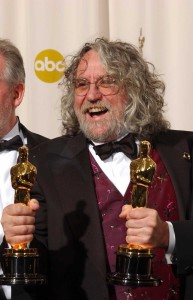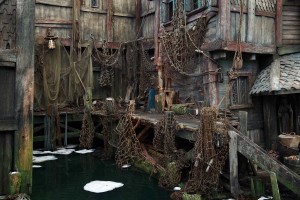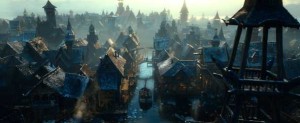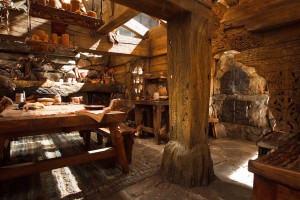
In addition to shooting three Hobbit films simultaneously, production designer Dan Hennah faced numerous additional production challenges with The Hobbit: The Desolation of Smaug. “We are building set pieces that are not the whole image that you see on the screen,” he explained, “due to the digital extension world – which is a huge bonus when you are making a 3D movie to give it depth.”
For Hennah, the new Hobbit film required massive interiors and exteriors equally, and realizing his work had to be planned with due deference to the film’s visual effects department. “We are going to use every tool in the toolbox,” he said of first contemplating work on the film. “We are going to try and make an epic movie. The only limitation is the imagination, and you take it from there.”
With 107 separate sets to be shot over 400 production days, Hennah’s crew averaged preparing a new set every four days. Shooting at Stone Street Studio in Wellington, New Zealand, Hennah had four stages at his disposal: one was 10,000-square-feet, two were 19,000-square-feet, and the fourth was 21,000-square-feet. Though Stone Street had a small workshop that Hennah utilized, most set construction occurred in workshops off-site in Trenton, which was an hour away. The nighttime art director, Brad Mill, supervised set construction and striking “24-hours-a-day and 7-days-a-week, with rotating crews working through the weekends,” said Hennah. “We used every hour there was to turn these things around.”

One advantage to Smaug’s production team was familiarity with previous approaches to Peter Jackson’s cinematic world. “We’ve all worked together before,” Hennah reflected, noting that his primary goal for each scene was “to give the actors a space and give Joe Letteri [visual effects supervisor] an edge.”
The aforementioned described “edge” would result in the end of Hennah’s physical sets and the beginning of Letteri’s planned digital set extensions. One particular set of note was the gigantic treasure room where Smaug the dragon is first encountered. “We were working in the 21,000-square-foot studio for the treasure room scene with 45 feet of stud height,” Hennah recalled. “We were able to build a big mountain of treasure on a 25-degree slope. We were able to build the tops of pillars and staircases and walls. We filled it up and made a line that Joe could work to so that he could add walls and additional treasure.”
Featuring Martin Freeman as young Bilbo Baggins poised on a mountain of jewelry and coinage as he discovers Smaug, the treasure room is surely one of Hennah’s most prominent set pieces in the film. “We had 150 10-liter pails of gold coins and coins that we painted gold leaf,” said Hennah. “We basically filled up the studio as far as we could go, and Joe took it from there. It was hard because you are on a slope and you are redressing it; everyone on the crew was sorting out jewelry.”
Another of Smaug’s production design centerpieces was the seaside village, Lake Town, also built on the 21,000-square-foot-stage. “It was an interactive set with real water and boats and ice on the water,” Hennah detailed. “We built a tank two-feet deep to row boats around. We built five different stages of Lake Town. We would pull it out and do it again in a different configuration. It was a huge undertaking. It was the one I love the most.”
 Lake Town also featured numerous practical buildings where actors could walk upstairs to houses and down alleys. “We built most of the components in 12 weeks in the workshops,” Hennah stated. “We built them all on big casters – wheels. Once we were ready, we would wheel them into position. We’d put in all the walkways and bridges then flood the set. It took two weeks to set it up in the stage. Down the canals once you got to the wall, you could extend. We [also] built a 50,000-square-foot Lake Town set on the backlot of Stone Street.”
Lake Town also featured numerous practical buildings where actors could walk upstairs to houses and down alleys. “We built most of the components in 12 weeks in the workshops,” Hennah stated. “We built them all on big casters – wheels. Once we were ready, we would wheel them into position. We’d put in all the walkways and bridges then flood the set. It took two weeks to set it up in the stage. Down the canals once you got to the wall, you could extend. We [also] built a 50,000-square-foot Lake Town set on the backlot of Stone Street.”
At its peak, Hennah’s art department featured 400 people, including jobs as specific as stained glass window makers, candlemakers and knifemakers. Though some objects were found, Hennah noted that most of Smaug’s set elements were made from scratch. “Every piece of furniture was made,” he said. “We made all of the boats and barrels for going down the river. We had a fabric factory where we made all of our flags and blankets. It wasn’t just a few construction workers and a set dresser or two. A lot of those people are artists in their own right that we were able to pull in and make their particular thing, but making it our way. A lot of that stuff involved moldmaking and casting. Everyone was learning something, and people were being trained in new skills. Across the board, it was a factory.”
 Working in concert with Hennah were four art directors, on-set art director Ben Milsom, set decorators Ra Vincent and Simon Bright, who was acting as the supervising art director, plus a dressing team. Set design teams worked with modelmakers so that Jackson could see set concepts in their three-dimensional form and define what he needed in order to get his shots. “We had a clean pre-production of six months, but the process kept going every day of the shoot right up until the end,” said Hennah. “ We didn’t have a sign off on every set until the day we had to stop building. That process carried on right through for four years.”
Working in concert with Hennah were four art directors, on-set art director Ben Milsom, set decorators Ra Vincent and Simon Bright, who was acting as the supervising art director, plus a dressing team. Set design teams worked with modelmakers so that Jackson could see set concepts in their three-dimensional form and define what he needed in order to get his shots. “We had a clean pre-production of six months, but the process kept going every day of the shoot right up until the end,” said Hennah. “ We didn’t have a sign off on every set until the day we had to stop building. That process carried on right through for four years.”
Of course, art direction on a film of the magnitude of Smaug does not cease with the completion of principal photography. “There is Joe’s work,” said Hennah of visual effects supervisor Letteri, “and I got our lead set designer to move in with Joe’s department. As they were designing and building digital set extensions, people were there representing the art department who were involved in the process from the beginning, so that there’s continuity in the design ethic.”
With visual effects primarily having taken over since principal photography wrapped, Hennah had time to reflect on his total Hobbit experience. “It’s been an exciting four years, and I’d love to do it again,” he said. “It’s always lovely to change the scale and go and do something a bit smaller. On the Hobbit films, every day, everything is changing. In the fantasy world, you can exercise your imagination a little more than the contemporary world for me. With the sheer volume, you don’t have any time to relax. You learn something new every day. You have to in order to survive.”





